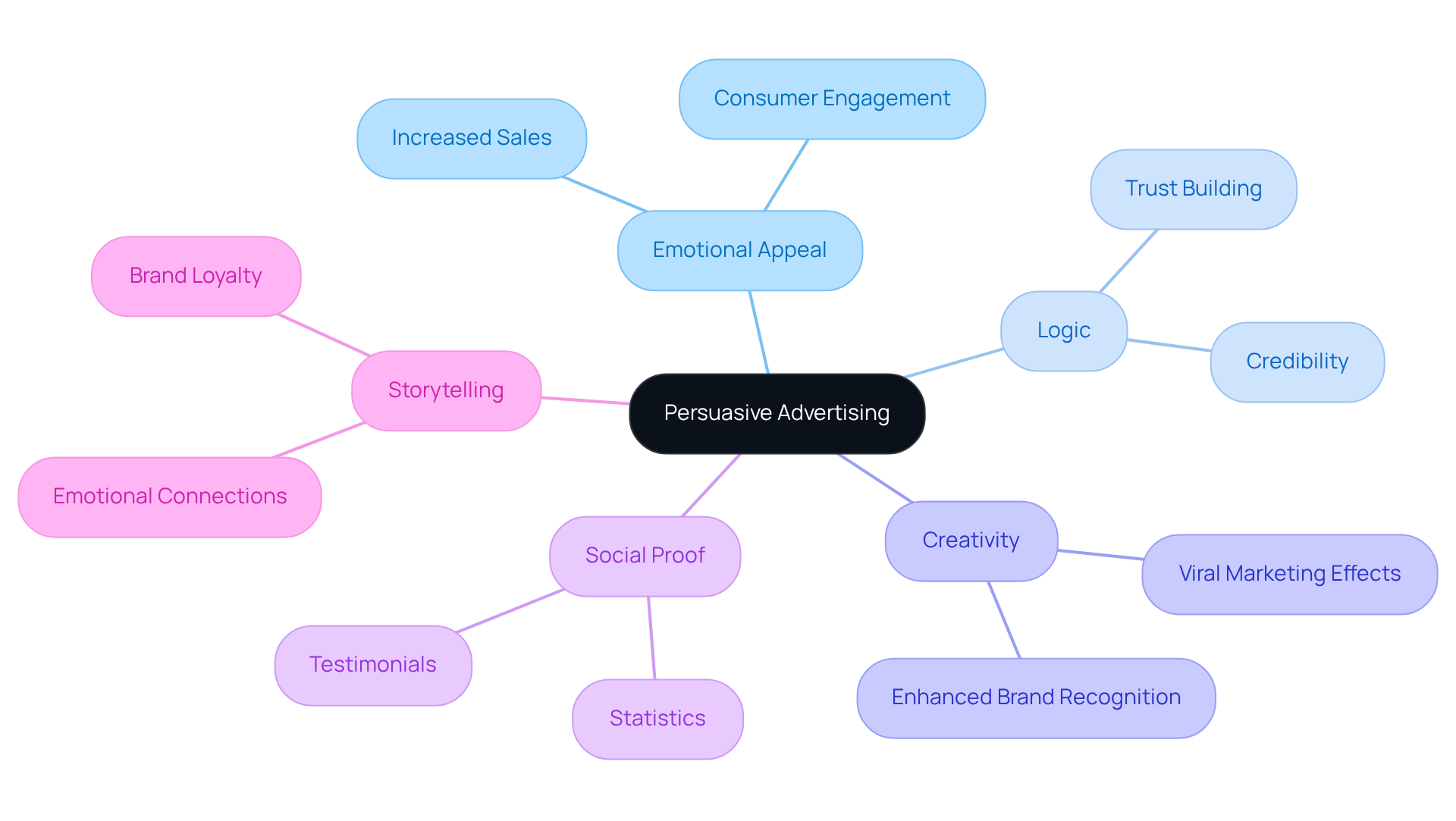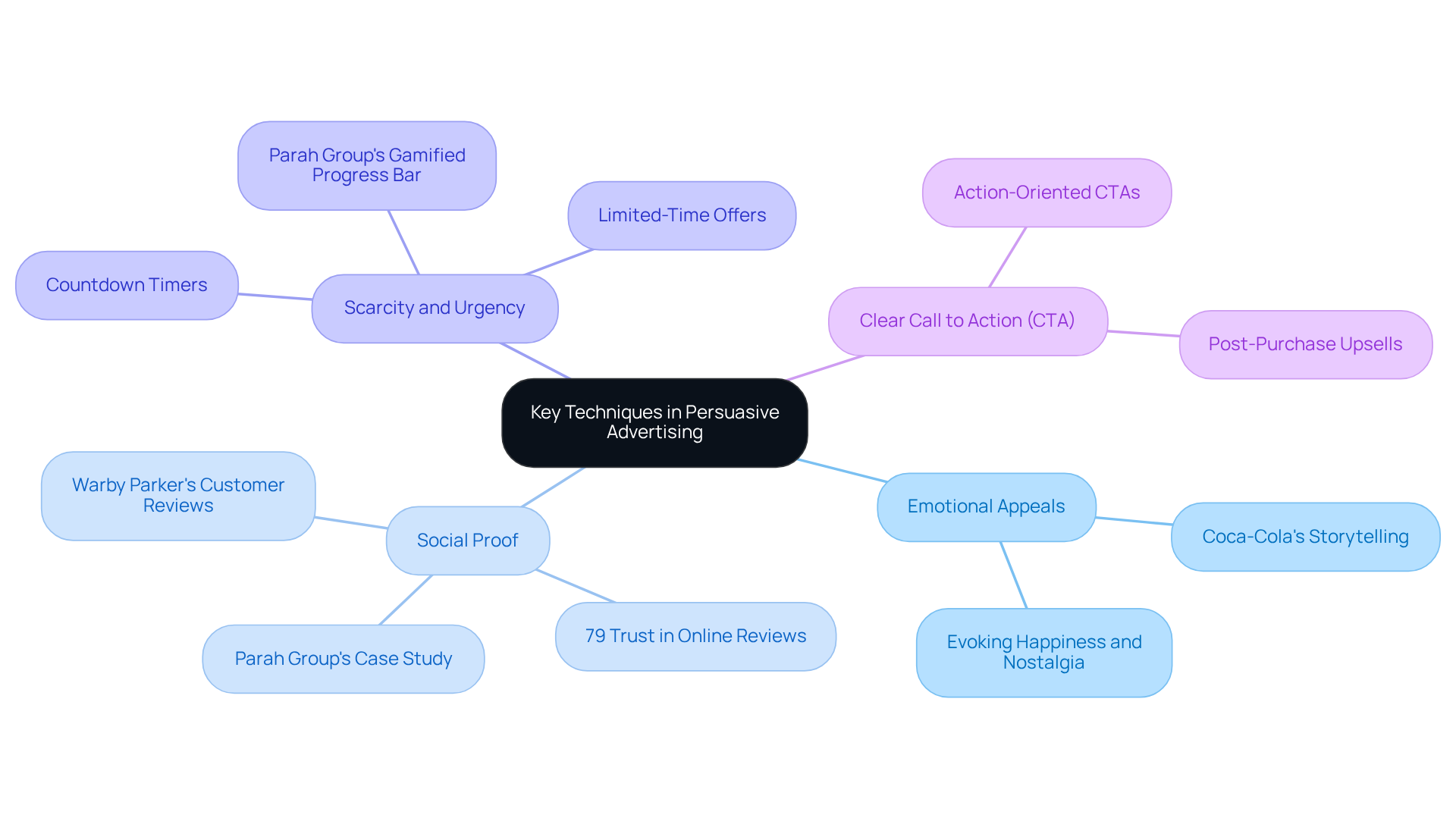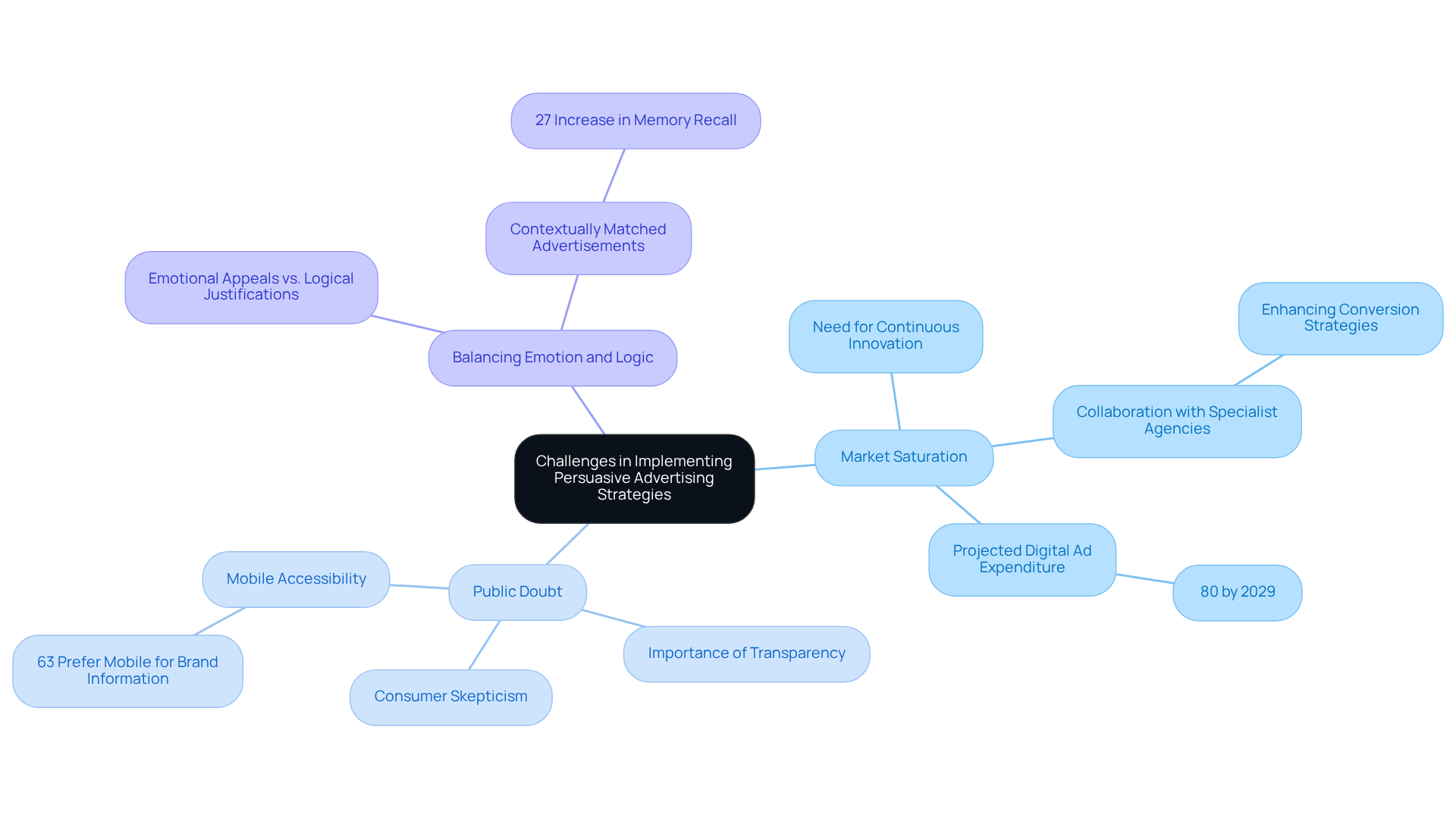
Overview
Persuasion in advertising for direct-to-consumer (DTC) brands exemplifies a powerful arsenal of techniques, including:
- Emotional appeals
- Social proof
- Scarcity
These strategies effectively influence consumer behavior and drive conversions. Notably, successful campaigns from brands like The Farmer's Dog and Warby Parker illustrate how these tactics forge emotional connections and establish trust. This ultimately leads to increased customer loyalty and sales. By harnessing these strategies, DTC brands can create compelling narratives that resonate with their target audience, prompting them to take action and engage with the brand.
Introduction
Persuasive advertising stands as a cornerstone of successful marketing strategies, especially for direct-to-consumer (DTC) brands navigating a fiercely competitive landscape. By leveraging psychological triggers that influence consumer behavior, brands can craft compelling narratives that resonate deeply with their audience, fostering emotional connections that drive both sales and loyalty.
Yet, as the market grows increasingly saturated, DTC companies must ask: how can they effectively harness these persuasive techniques to distinguish themselves and convert casual browsers into dedicated customers?
Delving into the nuances of emotional appeals, social proof, and urgency unveils the art and science behind impactful advertising strategies—strategies that not only capture attention but also inspire decisive action.
Defining Persuasive Advertising: Importance and Impact
Persuasive promotion embodies marketing strategies designed to influence consumer behavior by appealing to emotions, logic, and credibility. This approach is crucial for motivating potential clients to undertake specific actions, such as making a purchase or engaging with a company. The efficacy of persuasive advertising is particularly evident in the competitive realm of direct-to-consumer (DTC) companies, where effective communication is vital for driving sales. By leveraging psychological triggers that resonate with consumers, brands can craft compelling messages that not only attract attention but also foster emotional connections, leading to heightened conversion rates and enhanced customer loyalty.
Research underscores that advertisements marked by creativity and impact significantly sway purchasing behavior. For instance, imaginative advertisements are more likely to engage the audience, prompting them to share and discuss the content, which can yield viral marketing effects. Furthermore, the incorporation of social proof, including testimonials and statistics, enhances trust and validates the decisions made by consumers, thereby reinforcing the credibility of the company.
Successful campaigns within DTC companies serve as an example of persuasion in advertising, featuring tactics that elicit strong emotional responses or employ storytelling to resonate with their audience. These strategies not only differentiate brands in a saturated market but also cultivate lasting relationships with consumers, ultimately encouraging repeat purchases and brand loyalty. As the promotional landscape continues to evolve, grasping and implementing effective persuasive techniques will remain imperative for brands striving to excel in a competitive environment.

Key Techniques in Persuasive Advertising: Strategies for Success
Several key techniques are commonly employed in persuasive advertising, each designed to resonate with consumers and drive conversions:
-
Emotional Appeals: Advertisements that evoke emotions such as happiness, nostalgia, or fear forge a strong connection with consumers. Campaigns that tell relatable stories resonate more deeply than those focusing solely on product features. For instance, companies such as Coca-Cola have effectively employed emotional storytelling to create lasting connections, strengthening their products as representations of joy and sharing.
-
Social Proof: Utilizing testimonials, reviews, and influencer endorsements boosts credibility and motivates potential customers to trust the company. Direct-to-consumer (DTC) companies like Warby Parker effectively leverage customer reviews to build trust, showcasing real experiences that resonate with potential buyers. Research indicates that 79% of buyers trust online reviews as much as personal recommendations, highlighting the significant impact of social proof on trust. Parah Group's case studies illustrate this, as they revamped a homepage to emphasize social proof and reviews, resulting in a 35% increase in conversion rates for a $30 million clothing line.
-
Scarcity and Urgency: Creating a sense of urgency through limited-time offers or exclusive deals prompts consumers to act quickly. This technique is particularly effective in driving immediate sales, as seen in campaigns that emphasize limited stock or time-sensitive promotions. For example, brands that implement countdown timers on their websites often observe a notable increase in conversion rates. Parah Group's strategies included gamifying the progress bar for free shipping thresholds, significantly enhancing customer engagement and urgency.
-
Clear Call to Action (CTA): A well-defined CTA directs individuals on the next steps, whether it’s making a purchase or subscribing to a newsletter. Effective CTAs are action-oriented and create a sense of urgency, compelling consumers to take immediate action. Brands that incorporate strong CTAs in their advertising frequently experience higher engagement and conversion rates. Parah Group's implementation of post-purchase upsells and offers maximized profitability, showcasing the effectiveness of strategic CTAs.
By employing these techniques, DTC companies can craft compelling advertisements that are a prime example of persuasion in advertising, capturing attention and driving conversions, ultimately enhancing their profitability and market presence. Parah Group illustrates how creative conversion rate optimization (CRO) approaches, such as gamified progress bars and targeted post-purchase offers, can enhance DTC company profitability through proven results.

Real-World Examples of Persuasive Advertising: Case Studies and Insights
Numerous DTC brands have effectively harnessed persuasive advertising strategies, providing a clear example of persuasion in advertising, which has resulted in notable growth.
The Farmer's Dog exemplifies emotional storytelling, crafting advertisements that highlight the profound bond between pets and their owners. Their campaigns feature touching narratives that resonate with pet lovers, significantly driving engagement and sales. This approach taps into the emotional connection consumers have with their pets, fostering loyalty and encouraging repeat purchases.
Warby Parker stands out for its innovative marketing, utilizing social proof by prominently featuring customer testimonials and user-generated content in its advertisements. By showcasing the positive experiences of actual customers, the company enhances trust and encourages potential buyers to try their products. This strategy not only establishes credibility but also fosters a community around the brand, as satisfied customers share their experiences.
Ritual effectively employs scarcity in its marketing strategy by promoting limited-time offers and exclusive products. Their advertisements create a sense of urgency, encouraging individuals to act swiftly to secure their purchases. This tactic leverages psychological triggers that drive immediate action, enhancing conversion rates.
These examples act as an example of persuasion in advertising, illustrating how DTC brands can skillfully employ persuasive marketing techniques to create connections with their audience, foster trust, and ultimately drive conversions. The effectiveness of emotional storytelling, social proof, and scarcity in promotion underscores the significance of understanding buyer psychology in developing impactful marketing strategies.

The Role of Consumer Psychology in Persuasive Advertising
Buyer psychology is crucial to persuasive advertising, empowering marketers to comprehend how individuals think, feel, and act. Among the key psychological principles that drive consumer engagement are:
-
Reciprocity: This principle indicates that shoppers are more likely to respond positively to companies that offer something of value, such as free samples or useful content. By providing these incentives, companies cultivate a sense of obligation, encouraging individuals to reciprocate with purchases. Studies reveal that 82% of buyers are more inclined to purchase based on recommendations from trustworthy sources, underscoring the effectiveness of reciprocity in marketing. This principle is further supported by Robert Cialdini, who asserts that offering value can forge a strong connection between customers and companies.
-
Anchoring: This cognitive bias manifests when individuals assign significant weight to the first piece of information they encounter. For example, advertisements that present a higher initial price followed by a discount can render the final price more appealing, effectively swaying purchasing decisions.
-
Loss Aversion: Consumers exhibit a pronounced preference for avoiding losses rather than acquiring equivalent gains. Advertisements that highlight potential losses from not purchasing a product can be particularly persuasive, instilling urgency and prompting action.
By leveraging these psychological principles, DTC brands can craft compelling advertisements that are a prime example of persuasion in advertising, capturing interest and motivating individuals to take decisive action. Case studies illustrate that effective marketing strategies utilizing reciprocity—such as loyalty programs and free trials—serve as an example of persuasion in advertising, significantly enhancing customer engagement and fostering repeat purchases. For instance, the case study titled "Cultivating Brand Loyalty through Marketing" demonstrates how loyalty programs can nurture emotional connections with clients, transforming occasional buyers into repeat customers. Furthermore, as consumer demand for transparency and sustainability intensifies, companies that align their reciprocity strategies with these values can further bolster their market position. Understanding these dynamics enables companies to forge meaningful connections with their audience, ultimately resulting in increased sales and customer loyalty.

Challenges in Implementing Persuasive Advertising Strategies
While persuasive advertising can yield significant results, direct-to-consumer (DTC) brands encounter several notable challenges:
-
Market Saturation: In an increasingly crowded marketplace, distinguishing oneself is paramount. Brands must innovate continuously, refining their messaging and creative approaches to effectively capture consumer attention. With digital promotions projected to account for 80% of total ad expenditure by 2029, the competition for visibility is intense. Collaborating with a specialist agency such as Parah Group can assist DTC companies in enhancing their conversion strategies, ensuring that their promotional efforts achieve maximum impact.
-
Public Doubt: As digital promotions proliferate, consumers have become more discerning and skeptical of marketing messages. Establishing trust is crucial; companies can achieve this through transparency and authenticity in their advertising efforts. Research indicates that 63% of individuals prefer to find information about brands on mobile devices, underscoring the necessity for accessible and trustworthy content. A robust Conversion Rate Optimization (CRO) program, as provided by Parah Group, can facilitate data-informed decisions that bolster credibility and build trust among clients.
-
Balancing Emotion and Logic: Striking the right balance between emotional appeals and logical reasoning presents a complex challenge. Advertisements must resonate emotionally while also providing clear, rational justifications for purchase. Contextually matched advertisements, which align with the content users are engaging with, have demonstrated a 27% increase in global memory recall, underscoring the effectiveness of relevant messaging. By leveraging Parah Group's expertise in CRO, DTC companies can refine their messaging to connect with individuals on both emotional and logical levels.
By acknowledging these challenges and integrating the strategic insights from Parah Group, DTC brands can formulate more effective advertising strategies, serving as an example of persuasion in advertising that not only engage consumers but also drive conversions.

Conclusion
Persuasive advertising is crucial in shaping consumer behavior, especially for direct-to-consumer (DTC) brands. By skillfully engaging emotions, logic, and credibility, brands can craft compelling narratives that not only capture attention but also forge profound connections with their audience. This strategic approach is indispensable for driving sales and nurturing customer loyalty in an increasingly competitive landscape.
The article highlights key techniques such as:
- Emotional appeals
- Social proof
- Scarcity
- Clear calls to action
These are powerful instruments in the arsenal of persuasive advertising. Real-world examples, including successful campaigns from brands like The Farmer's Dog and Warby Parker, demonstrate how these strategies can yield significant engagement and conversion rates. Furthermore, a deep understanding of consumer psychology—particularly principles like reciprocity and loss aversion—empowers brands to create messages that resonate profoundly, ultimately enhancing their market presence.
As the advertising landscape evolves, the mastery of persuasive techniques is paramount. DTC brands must remain agile, continually refining their strategies to navigate challenges such as market saturation and consumer skepticism. By doing so, they can capture the attention of potential customers and cultivate enduring relationships that drive repeat business. Embracing these insights and strategies will enable brands to flourish in a dynamic environment, ensuring their messages resonate and inspire action among their target audiences.
Frequently Asked Questions
What is persuasive advertising?
Persuasive advertising refers to marketing strategies aimed at influencing consumer behavior by appealing to emotions, logic, and credibility. It motivates potential clients to take specific actions, such as making a purchase or engaging with a company.
Why is persuasive advertising important for DTC companies?
In the competitive landscape of direct-to-consumer (DTC) companies, effective communication through persuasive advertising is crucial for driving sales. It helps brands create compelling messages that resonate with consumers, leading to higher conversion rates and enhanced customer loyalty.
What role do psychological triggers play in persuasive advertising?
Psychological triggers are used to craft messages that attract attention and foster emotional connections with consumers. This approach can lead to increased conversion rates and stronger relationships with customers.
How does creativity in advertising affect consumer behavior?
Creative advertisements are more likely to engage audiences and prompt them to share and discuss the content, which can result in viral marketing effects and significantly sway purchasing behavior.
What is the significance of social proof in persuasive advertising?
Social proof, such as testimonials and statistics, enhances trust and validates consumer decisions, thereby reinforcing the credibility of a company. It motivates potential customers to trust the brand and is crucial for driving conversions.
What are some key techniques used in persuasive advertising?
Key techniques include emotional appeals, social proof, scarcity and urgency, and clear calls to action (CTA). Each of these techniques is designed to resonate with consumers and drive conversions.
How do emotional appeals work in advertising?
Emotional appeals evoke feelings such as happiness, nostalgia, or fear, creating a strong connection with consumers. Campaigns that tell relatable stories tend to resonate more deeply than those that focus solely on product features.
What is the impact of scarcity and urgency in advertising?
Creating a sense of urgency through limited-time offers or exclusive deals encourages consumers to act quickly, often leading to immediate sales. Techniques like countdown timers can significantly increase conversion rates.
What constitutes a clear call to action (CTA)?
A clear CTA directs consumers on the next steps to take, such as making a purchase or subscribing to a newsletter. Effective CTAs are action-oriented and create a sense of urgency, leading to higher engagement and conversion rates.
How can DTC companies enhance their profitability through persuasive advertising?
By employing persuasive techniques such as emotional appeals, social proof, and strategic CTAs, DTC companies can create compelling advertisements that capture attention and drive conversions, ultimately enhancing their market presence and profitability.
FAQs











